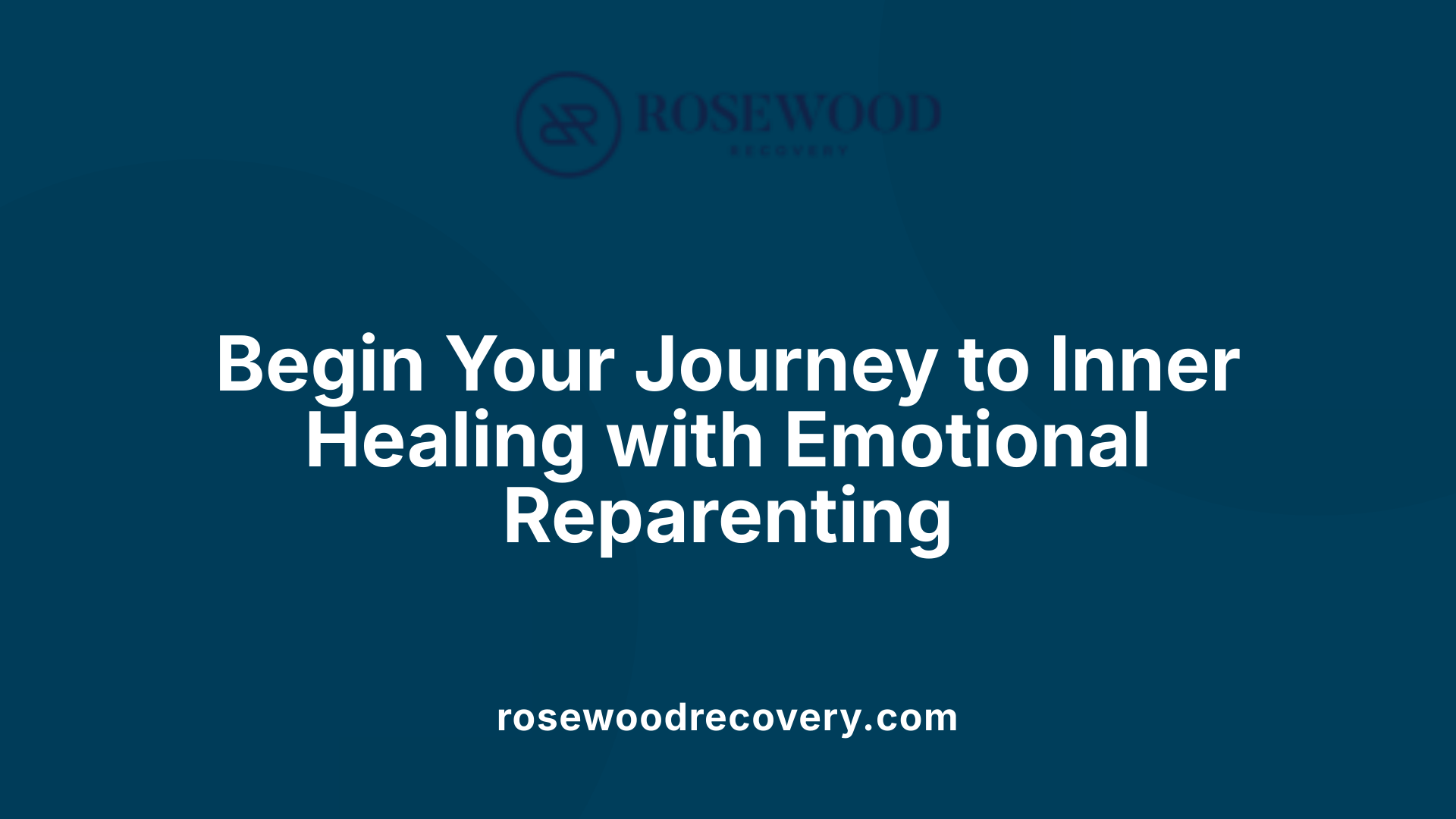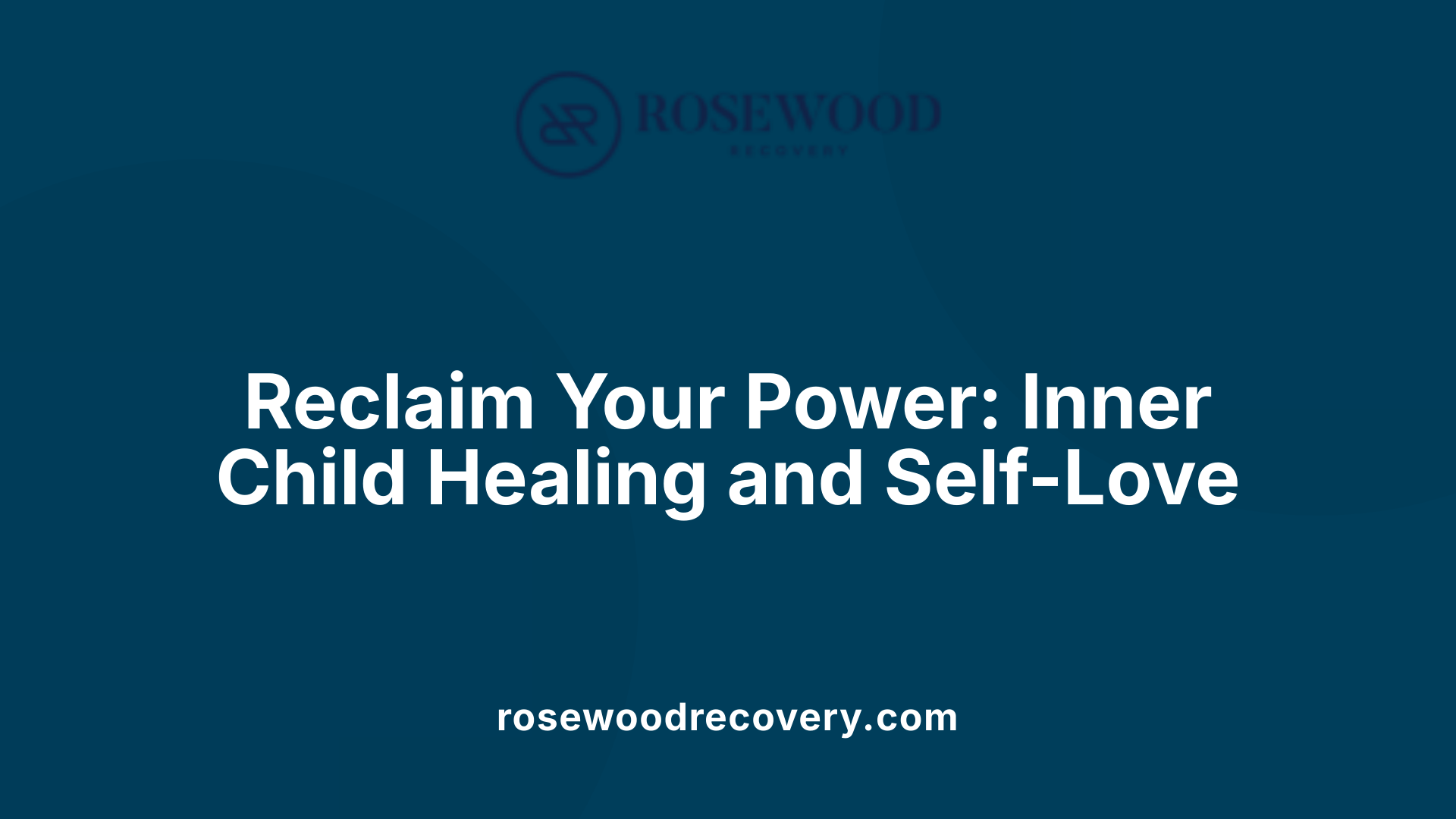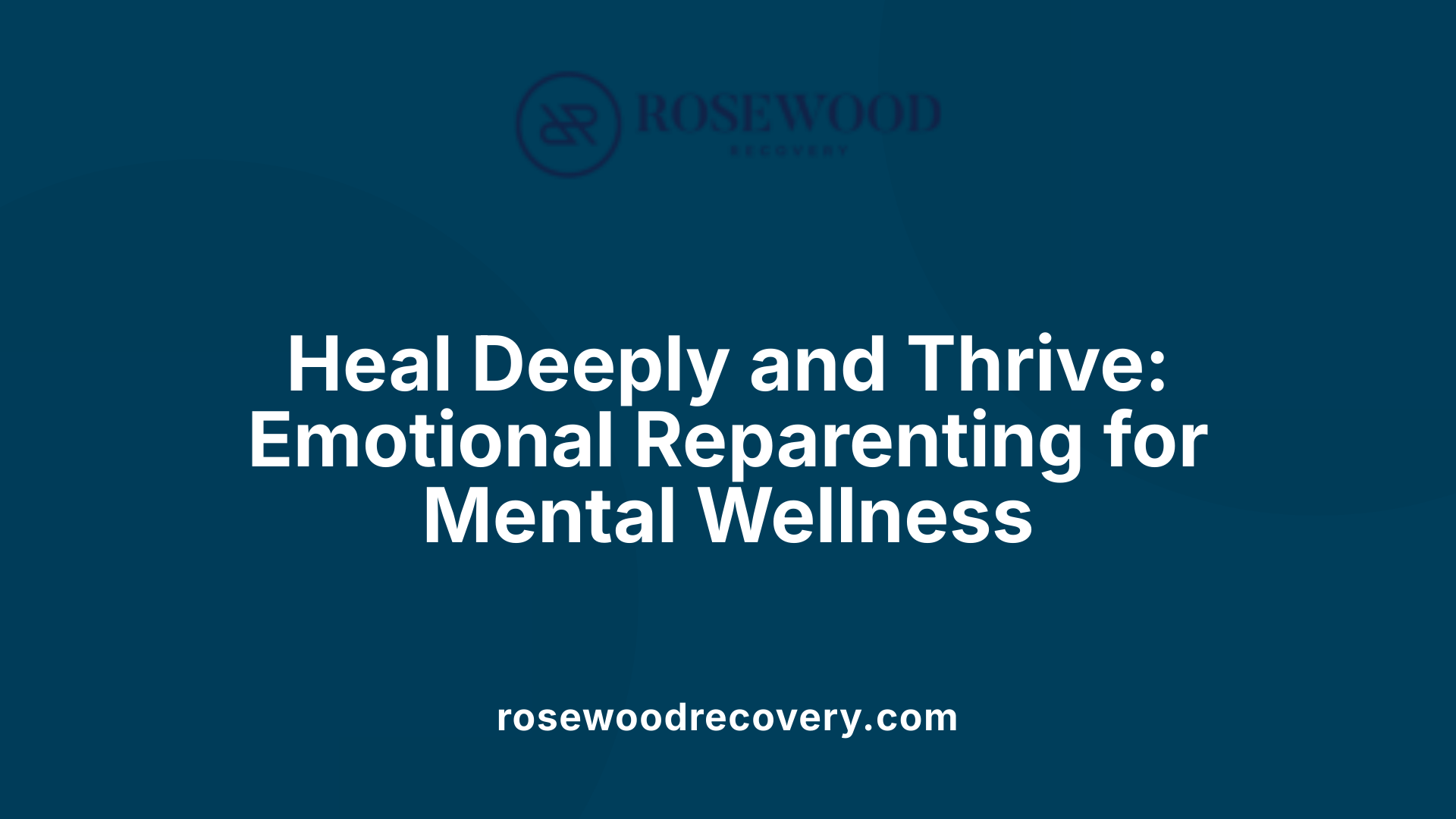Understanding Emotional Reparenting: A Pathway to Inner Healing
Emotional reparenting is a transformative process that enables individuals to heal wounds from childhood by consciously nurturing their inner child. Rooted in principles of self-compassion, emotional regulation, and joyful self-discovery, it offers a pathway to emotional recovery, resilience, and healthier relationships. This article explores what emotional reparenting entails, its core principles, techniques, and how it facilitates healing from trauma and emotional wounds.
What Is Emotional Reparenting and Its Core Principles
What is emotional reparenting and what are its core principles?
Emotional reparenting is a transformative healing process where individuals consciously nurture and fulfill the unmet emotional, physical, and spiritual needs from their childhood. It stems from the understanding that many adults carry emotional wounds caused by unmet needs, often due to emotionally unavailable or unaware caregivers.
This process involves actively addressing these past deficiencies by developing a compassionate, understanding inner voice—sometimes called the inner parent—that provides validation, love, and boundaries. The goal is to heal wounds rooted in early experiences of neglect, inconsistency, or lack of affection.
At the heart of emotional reparenting are several guiding principles. Self-compassion is crucial, as it encourages kindness toward oneself and combats negative self-talk. Emotional regulation helps in processing difficult feelings through mindfulness, journaling, and calming techniques, creating space for healing.
Loving discipline forms part of the process, involving establishing healthy routines, routines, and boundaries that support personal growth. Self-care emphasizes nurturing the body and mind through proper nutrition, rest, and physical activity while honoring one’s emotional needs.
An essential component is reconnecting with a childlike sense of wonder. Engaging in creative activities, play, or joyful routines helps the inner child feel safe and loved.
These principles often come together through practices such as mindfulness, affirmations, and the establishment of positive routines. Whether pursued independently or within therapy, emotional reparenting aims to unearth and heal emotional wounds, foster self-love, and restore the vitality and joy often missing in adulthood due to childhood trauma.
Ultimately, by developing an inner parental figure that embodies compassion and wisdom, individuals can improve their relationships, reduce negative patterns, and cultivate a sense of inner peace and resilience.
Facilitating Emotional Recovery and Healing

How does emotional reparenting facilitate emotional recovery and healing?
Emotional reparenting plays a vital role in healing childhood wounds by nurturing and caring for the inner child, which often bears scars from unmet needs or traumatic experiences. This approach encourages individuals to revisit and address past emotional neglect or hurt, fostering self-compassion and understanding.
Practices such as developing self-awareness, practicing mindfulness, and engaging in positive inner dialogue are instrumental. These techniques help individuals recognize their emotional triggers, validate their feelings, and create supportive internal conversations that were missing in childhood.
By actively working to meet unresolved emotional needs—like feelings of love, safety, and acceptance—people can reframe negative thought patterns rooted in early life. This process supports healthier emotional regulation, reduces self-criticism, and promotes self-acceptance.
Building self-compassion through consistent nurturing routines enhances resilience, enabling individuals to face future challenges with greater strength. As they grow more comfortable reconnecting with their authentic selves, they also improve their relationships with others.
Ultimately, emotional reparenting helps establish a secure inner foundation. It allows individuals to process and heal past traumas, fostering emotional stability, confidence, and a more positive outlook on life. This transformative journey leads to a profound sense of well-being and personal growth.
Benefits for Mental Health and Emotional Well-Being

What are the benefits of emotional reparenting for mental health and emotional well-being?
Emotional reparenting provides a powerful way to address unresolved childhood wounds, which often influence adult mental health. By nurturing the inner child and meeting unmet emotional needs, individuals can cultivate a healthier inner dialogue and develop more stable emotional patterns.
One of the key advantages is the boost in self-esteem and self-compassion. When people learn to soothe inner distress and challenge negative beliefs rooted in childhood, they often experience reduced feelings of shame and self-criticism. This shift improves overall emotional regulation, helping individuals handle stress, anxiety, and mood swings better.
Reparenting also plays an important role in reducing symptoms related to anxiety, depression, and Complex PTSD (CPTSD). Healing past neglect or trauma enables individuals to break free from destructive emotional cycles and experience greater resilience. Furthermore, as emotional regulation improves, people tend to form healthier relationships because they are less reactive and more empathetic.
Practices like mindfulness, visualization, and inner child work foster emotional intelligence, enhancing one's ability to understand and manage feelings effectively. This self-awareness translates into more authentic connections with others and a stronger sense of self-worth.
Overall, emotional reparenting empowers individuals to transform their internal experiences, leading to lasting improvements in mental health, greater emotional stability, and a more fulfilling life. It encourages a compassionate relationship with oneself, creating a foundation for sustained emotional well-being.
Techniques and Exercises in Emotional Reparenting

What techniques and exercises are used in emotional reparenting practices?
Emotional reparenting employs a variety of techniques and exercises designed to nurture and heal the inner child. One of the foundational practices is self-compassion, which involves treating oneself with kindness and understanding, especially when confronting painful memories. Affirmations are also widely used; repeating positive statements helps reframe negative self-talk rooted in childhood wounds.
Inner child dialogue is another powerful tool. This involves engaging in conversations with your inner child—either by speaking aloud or through writing—to validate feelings and offer reassurance. Visualization techniques help create a mental image of safety and nurturing, often involving imagining a supportive figure providing comfort.
Writing letters to one's inner child is a popular exercise that allows individuals to express feelings they may have felt unable to articulate in childhood. These letters can be compassionate, apologetic, and forgiving, facilitating emotional release.
Creative activities, like drawing, painting, or playing, reconnect the inner child to joy and spontaneity. Mindfulness practices, such as observing physical sensations or using feeling wheels, help increase awareness of emotional states and promote grounding.
Setting boundaries and trusting intuition are essential for emotional safety. Reparenting involves learning to identify what is acceptable and listening to your emotional cues for guidance.
Mirror work, which entails looking into a mirror and speaking kindly to oneself, enhances self-acceptance and self-love. Shadow work, another technique, involves exploring hidden or suppressed parts of oneself to foster integration and healing.
In therapy, guided imagery and working with an inner child specialist can deepen these exercises, providing a safe space to revisit and revise traumatic memories. Overall, these tools serve to meet unmet childhood needs, validate feelings, establish emotional safety, and cultivate resilience, opening pathways to healthier self-relationships and emotional well-being.
Healing Childhood Wounds and Traumas
How does emotional reparenting support the healing of childhood emotional wounds and trauma?
Emotional reparenting plays a vital role in healing childhood wounds by helping individuals reconnect with their inner child—the part of themselves that experienced unmet needs and emotional scars. This process involves consciously nurturing the inner child by addressing core needs that may have been neglected, such as validation, love, physical safety, and emotional understanding.
Using techniques like positive self-talk, mindfulness, journaling, and setting healthy boundaries, where individuals speak to and soothe their inner child, facilitates confrontation of suppressed memories and painful experiences. These methods enable a person to process emotions that were previously ignored or avoided, fostering emotional regulation and resilience.
Reparenting serves as a transformative approach that helps correct dysfunctional patterns developed from childhood, such as low self-esteem, mistrust, or self-sabotage. It encourages building self-trust and developing healthier responses to stress and emotional challenges.
By restoring a sense of safety, love, and acceptance within oneself, emotional reparenting reduces trauma symptoms such as anxiety and feelings of worthlessness. It also cultivates a secure inner foundation that supports healthier relationships and emotional stability.
Moreover, this practice promotes profound personal growth by enabling individuals to forgive past hurts, rebuild their sense of identity, and develop a compassionate internal dialogue. Ultimately, emotional reparenting offers a powerful pathway to healing deep-seated wounds, allowing for a more fulfilled and emotionally resilient life.
The Role of Emotional Reparenting in Self-Healing and Inner Child Work

What role does emotional reparenting play in self-healing and inner child work?
Emotional reparenting is essential in the journey of self-healing and nurturing your inner child. It involves addressing unmet emotional needs from childhood by providing yourself with the love, support, and affirmation that may have been absent during early years. This process helps individuals reconnect with their wounded inner child, allowing them to heal past trauma, low self-esteem, and emotional distress.
By engaging in reparenting, adults can develop healthier emotional patterns and improve their self-relationship. Techniques such as positive affirmations, visualization exercises, and mindfulness practices are instrumental. These tools help re-establish a loving and supportive inner voice, fostering greater self-acceptance and emotional resilience.
Moreover, reparenting helps resolve trust issues, optimize boundaries, and boost self-worth. It creates a secure internal environment where emotional regulation becomes easier, and personal growth is supported. As a result, individuals often experience improved relationships, reduced anxiety, and a stronger sense of self. Overall, emotional reparenting acts as a powerful method to heal childhood wounds and promote psychological well-being, enabling a more fulfilling and emotionally balanced life.
Application of Emotional Reparenting in Therapy
How can emotional reparenting be applied in therapeutic contexts?
Emotional reparenting is a powerful approach used in therapy to help individuals heal childhood emotional wounds. Therapists guide clients in identifying unmet needs from their early years, such as feelings of safety, validation, love, and acceptance. These needs often influence how people behave and relate to others as adults.
To facilitate healing, therapists employ various techniques including inner child work, journaling, mindfulness, and visualization exercises. Inner child work involves engaging with the wounded parts of oneself, often through writing letters or dialogues that express suppressed feelings and needs.
Journaling helps clients explore their past experiences and recognize patterns rooted in childhood trauma. Mindfulness practices foster emotional awareness, allowing individuals to observe their feelings without judgment and develop healthier ways to process them.
A critical part of reparenting in therapy is reframing past trauma. Clients learn to view their childhood experiences with compassion, reducing self-blame, and rewriting negative beliefs about themselves and the world. This process unlearns harmful patterns such as self-criticism or avoidance.
Building self-compassion and resilience is central to long-term healing. Therapists assist clients in developing a kind internal dialogue, reinforcing their worth, and fostering a sense of safety within themselves. This emotional foundation enables clients to better regulate their feelings and set healthy boundaries.
Supporting relationship healing is often an outcome of reparenting work. As individuals nurture their inner child, they improve their capacity for trust, intimacy, and effective communication. The overall goal is to help clients establish secure internal and external relationships, promoting emotional well-being.
In summary, emotional reparenting in therapy involves addressing unmet childhood needs, practicing inner child techniques, reinterpreting past trauma, and fostering self-compassion. This holistic approach helps individuals heal deep-seated wounds and develop a healthier, more resilient emotional life.
Supporting Recovery From Anxiety, Depression, and CPTSD

How does emotional reparenting support recovery from issues like anxiety, depression, and CPTSD?
Emotional reparenting plays a vital role in healing mental health challenges such as anxiety, depression, and complex post-traumatic stress disorder (CPTSD). At its core, it addresses the unresolved emotional wounds and unmet needs from childhood that often contribute to these issues.
By engaging in self-compassion, positive self-talk, and inner child work, individuals learn to nurture themselves with kindness and understanding. This nurturing fosters a sense of safety and trust within oneself, helping to reduce feelings of fear, shame, and insecurity — common underpinnings of anxiety and depression.
In addition to fostering inner safety, reparenting enhances emotional regulation. This means individuals become better equipped to process difficult emotions, break free from maladaptive patterns, and develop resilience. These skills are crucial for managing stress and preventing setbacks.
Transforming negative core beliefs acquired during childhood is another significant benefit. Reparenting helps replace harmful narratives with healthier and more empowering ones, enabling a person to build a more positive self-image.
Overall, emotional reparenting supports recovery by healing emotional wounds, cultivating self-acceptance, and creating a stable foundation for mental wellness. It empowers individuals not only to cope better but also to thrive by fostering a deep sense of internal safety, trust, and resilience.
An Illustrative Example of Emotional Reparenting in Practice
Recognizing Unmet Needs
An important first step in emotional reparenting is recognizing the emotional needs that were left unfulfilled during childhood. These needs might include feelings of safety, unconditional love, validation, or consistent support. When adults become aware of these gaps, they can begin to address them consciously, rather than unconsciously repeating patterns from the past.
Practicing Self-Compassion and Boundaries
Once aware, individuals can nurture their inner child through self-compassion. This involves speaking to oneself kindly, challenging negative self-talk, and setting healthy boundaries that promote emotional safety. For example, saying, "I am worthy of love and safety," reinforces positive self-perception. Developing boundaries helps protect the inner child from ongoing harm or neglect, creating a foundation for trust and healing.
Using Techniques like Letter Writing and Visualization
Effective methods include writing letters to the inner child, where one acknowledges feelings, offers reassurance, and validates past pain. Visualization exercises can also be powerful; imagining oneself as a caring, supportive caregiver for the inner child, provides a mental space for nurturing behaviors.
Healing Past Wounds
Through consistent application of these techniques, individuals start to heal emotional scars rooted in childhood trauma. Shadow work and mirror exercises further deepen the connection with the inner child, creating an environment of compassion and understanding.
By actively engaging in these practices, adults help their wounded inner child feel safe, loved, and validated. This personalized approach to reparenting fosters emotional resilience, enhances self-esteem, and facilitates the recovery from past neglect or trauma. Ultimately, it empowers individuals to develop healthier relationships with themselves and others, nurturing long-term emotional well-being.
Embracing the Journey to Inner Healing
Emotional reparenting is a powerful and ongoing journey toward healing and self-discovery. By consciously meeting unmet childhood needs through techniques like nurturing inner dialogue, boundary setting, and self-compassion, individuals can transform their emotional landscapes. This process not only heals past wounds but also fosters resilience, healthier relationships, and a more joyful, authentic life. Embracing reparenting as a lifelong practice enhances mental well-being and unlocks the full potential of one’s inner vitality, leading to profound personal growth and inner peace.
References
- Reparenting: Seeking Healing for Your Inner Child
- What Is 'Reparenting' and Should You Try It? - The New York Times
- Reparenting in Therapy: Healing Your Inner Child - Talkspace
- What is Reparenting and How to Begin - The Holistic Psychologist
- What Is Reparenting? A Guide to Healing Your Inner Child
- Reparenting in Therapy - Verywell Mind
- How Reparenting Yourself Can Ease Anxiety - Joyfeel Therapy

.jpeg)


